 Abraham Lincoln
If given the truth, the people can be depended upon to meet any national crisis...
Abraham Lincoln
If given the truth, the people can be depended upon to meet any national crisis...
 Guildford news...
for Guildford people, brought to you by Guildford reporters - Guildford's own news service
Guildford news...
for Guildford people, brought to you by Guildford reporters - Guildford's own news service
Walking Along The Wey at Godalming with David Rose
Published on: 19 Aug, 2024
Updated on: 19 Aug, 2024
By David Rose
In 1764 the Godalming Navigation opened… finally linking the town to England’s main canal network.
Yes finally, as the River Wey Navigation from Guildford to Weybridge had been completed and opened in 1653. It is part natural river and part man-made canal cuts. And it was one of the first British rivers to become navigable.
Work began much later in 1760 to make the four miles of waterway from Guildford to Godalming navigable. This included one and a half miles of canal and four locks.
It provided a boost to several of Godalming’s trades and industries with cargos carried on the waterway that included vast quantities of timber, corn and stone.
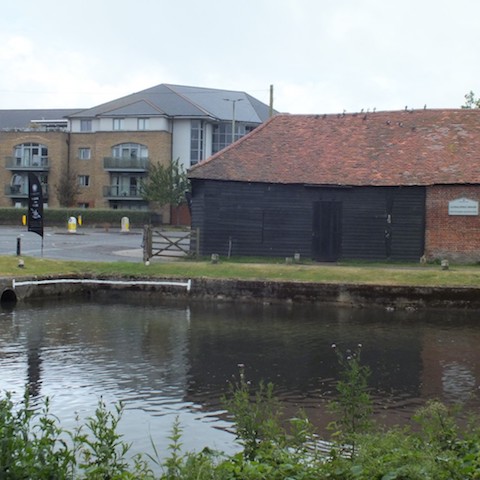
Godalming Wharf. All photos by Jack Renaud.
The heyday of Godalming Wharf was in about 1810 when traffic towards London included the said timber planks, bark, flour, and iron products of various sorts.
I lead free guided walks with a focus on local history for the National Trust. It looks after the River Wey and Godalming Navigations with its headquarters at Dapdune Wharf in Guildford.
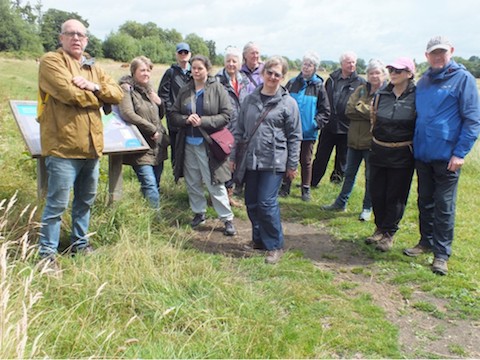
David Rose (far left) with the group who came on the walk on Saturday, July 6.
The walk I led in July took in a stretch of the Godalming Navigation. Keen photographer Jack Renaud took all the photos seen here, using his artist eye.
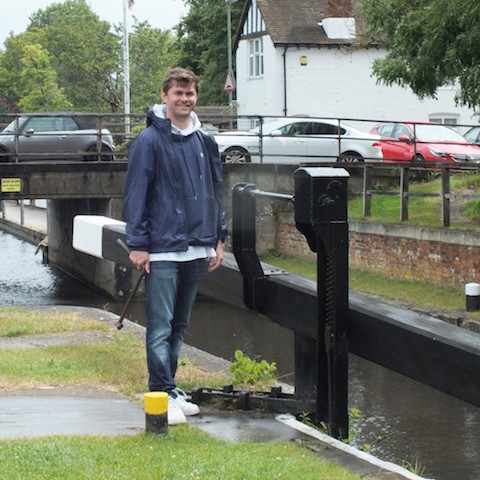
A boater navigating Catteshall Lock.
We started at Godalming Wharf and walked along the towpath down stream to Catteshall Lock, and then back via the eastern part of Godalming’s Lammas Lands water-meadows.
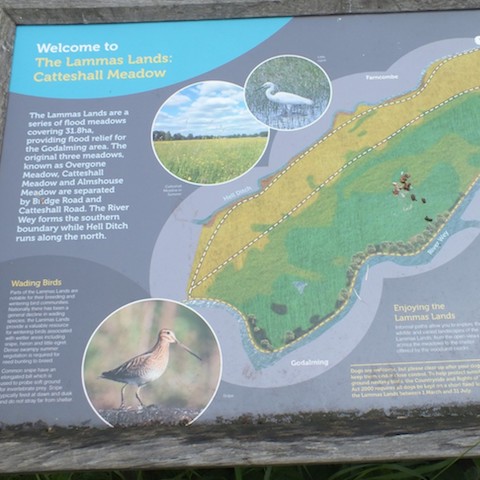
Notice board giving details the Lammas Lands.
The name is derived from the tradition that forbade farmers to graze cattle on such meadows from spring until after the summer crop of hay had been cut.
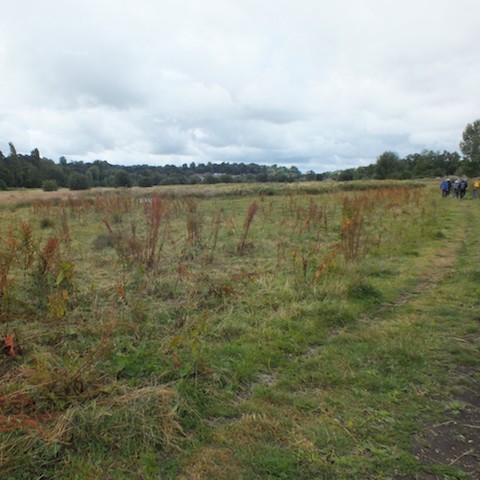
The Lammas Lands at Catteshall.
There are four water-meadows totalling 31.8 hectares and recognised as sites of high importance for their biodiversity. Cattle are also grazed here.

Calf on the Lammas Lands.
Waverley Borough Council designates them as an area of strategic visual importance.
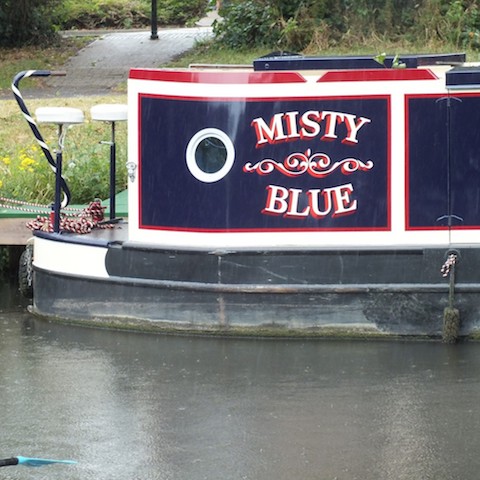
Stern of a moored narrowboat.
Once back at Godalming Wharf the walk continued upstream on the non-navigable River Wey, passing through Phillips Memorial Park.
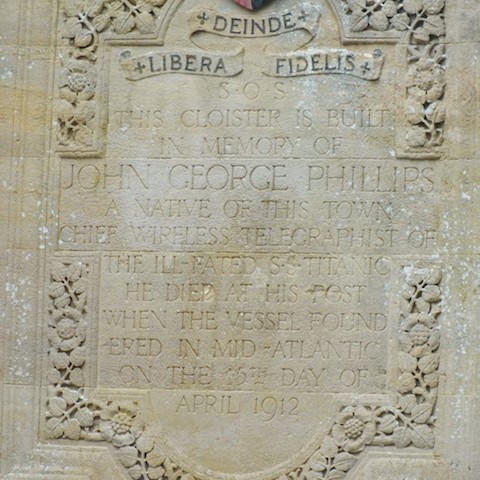
Plaque commemorating Jack Phillips in the memorial cloister.
Many will know that it’s named after Jack Phillips, who was born in Farncombe in 1887. He first worked as a telegraph operator in Godalming. He then worked for the Marconi company, and later joined the White Star Line as its chief wireless operator on the ship RMS Titanic.
He died when the Titanic sunk on the night of April 14-15, 1912. He had been sending the new distress message S.O.S.
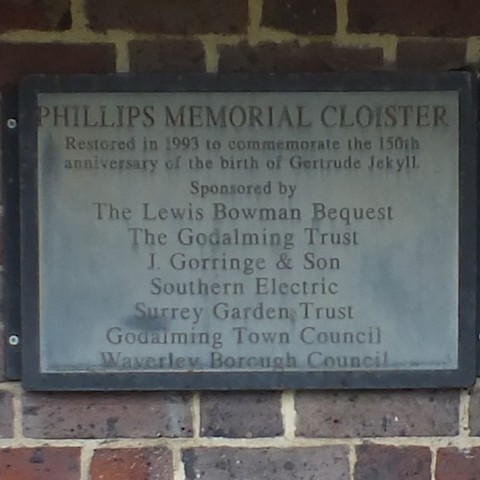
Plaque with details of the cloister’s restoration.
In the park, the memorial cloister to Jack Phillips was built in 1913 and was designed by English Arts and Crafts architect Hugh Thackery Turner, with the garden designed by Gertrude Jekyll, who were both local residents of the area.
Godalming has a history of industry. The woollen trade was an important cottage industry for the town during the later Middle Ages and into the 16th century. It was later replaced by machine or framework knitting, the first record in Godalming being in 1681.
Tanning was a local industry from perhaps as early as the 15th century, while paper-making was also important to the town from the middle of the 17th century.
Access to water was vital for these industries and to power the mills.

Marker to measure depth of the water.
Westbrook Mills was one of three sites in Godalming where there were mills, the others being at Catteshall and Eashing.
Here the River Ock joins the River Wey and there was a fulling mill here as early as 1483, later silk and leather mills.
The upper mill at Westbrook was known as Salgsson Mill, dating to 1732 when it manufactured paper.
There was once a saying that you knew when your train had arrived at Godalming by opening the carriage window and taking in the awful smell coming from the tanneries!
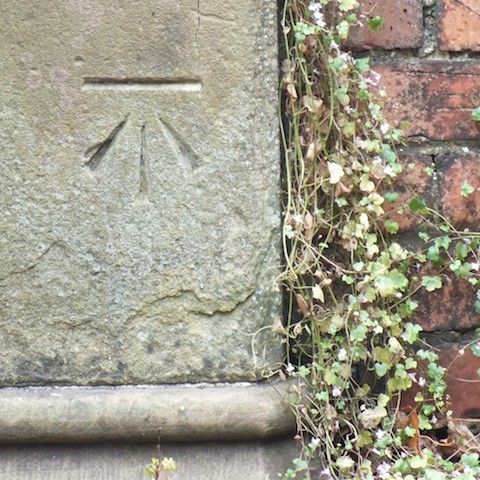
Ordnance Survey’s benchmark for surveyors to confirm the height of a feature in relation to Mean Sea-Level.
Today Westbrook Mills is a development of 128 one- and two-bedroom apartments for sale or to let.
Godalming is recognised as has having the world’s first public electricity supply.
The Surrey Advertiser of October 1, 1881, reported: “The motive power to generate the current being an auxiliary face waterwheel at the Westbrook Mills, of Messrs Pullman brothers, the skin dresses, who have made arrangements for lighting the mills with the Swan lights, and for the larger open spaces with Siemen’s differential lamps of 300 candle-powder each.”
It was once often stated that Godalming had the “world’s first electric street lighting”, but other cities and towns had already installed electric street lights, including Paris, London, San Francisco and even Blackpool!
However, it was the first place in the world to have public electricity. Unfortunately, there was little take up for the idea and the service was discontinued in 1884, and electricity did not return to Godalming until 1910.
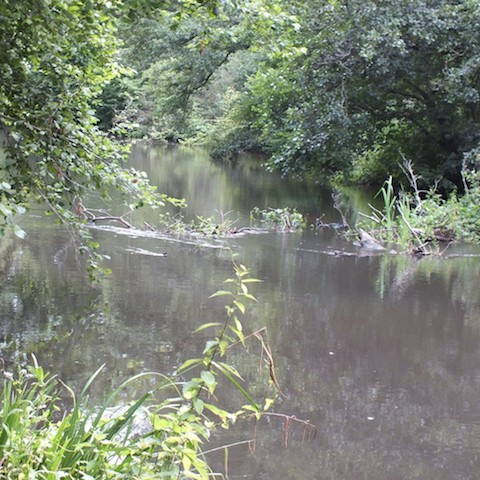
The non-navigable River Wey upstream from Westbrook Mills.
The walk upstream beside the natural river is a delight, with trees lining the water, some with their branches touching the water itself.

Himalayan balsam in bloom.
Summer time means the vegetation is lush. There’s plenty of the non-native but invasive Himalayan balsam (Impatiens glandulifera) with it pink flowers.
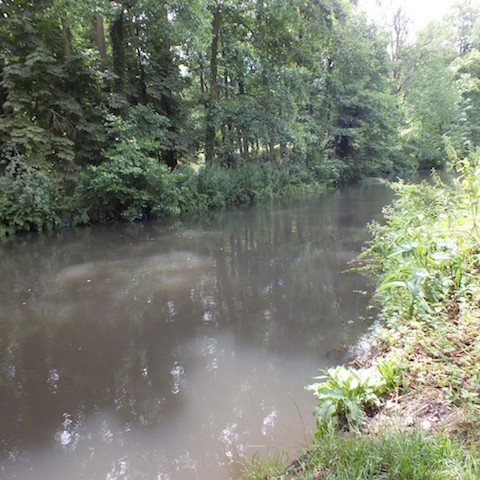
Tranquil water and delightful trees.
Thanks to volunteers from Godalming Angling Society, the paths beside the river and the sections for the anglers to fish from are kept in check.
You can only go so far beside the river here before the the public right of way ends. However, there are two things to notice. One being a fish pass that’s been built to help fish swim upstream, and a Second World War fortified “pillbox”, defensive structure in case of invasion by the Nazis.
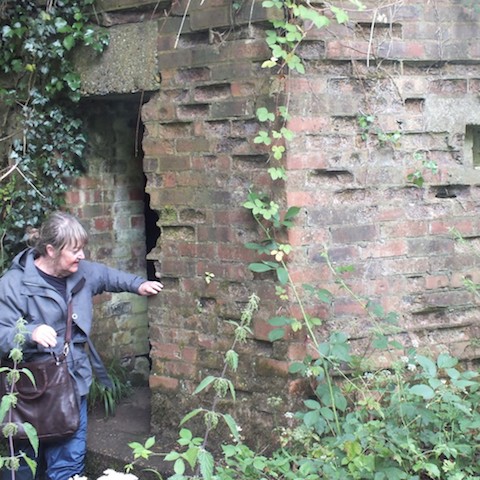
The Second World War pillbox.
A footpath leads up to Peperharow Road. My walk went down it a short way before taking another path back to the river and then on to Godalming town centre to finish.
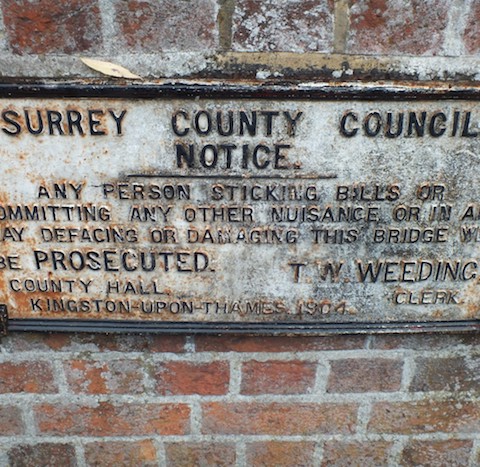
Surrey County Council bridge notice.
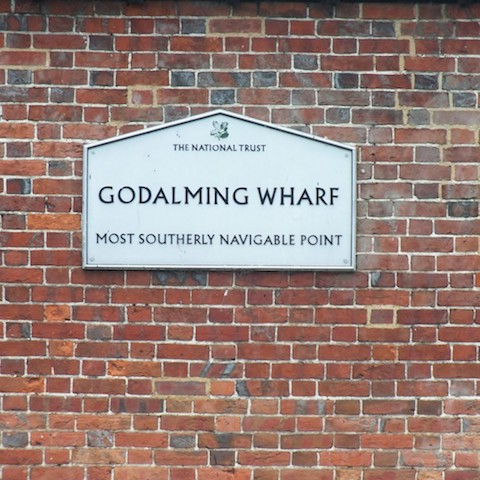
National Trust sign at Godalming Wharf.
Thanks to Sarah Crawcour, visitor experience manager at the National Trust River Wey and Godalming Navigations, to Jack Renaud who came along and took the photos, and everyone who came on the walk. We had a great time!
Not to be missed… Guildford Walkfest is coming up and runs throughout September with lots of different walks hosted by a number walk groups, town guides and more. I’m leading three walks: Monday, September 2: circular walk from The Hive community centre at Park Barn taking in Broadstreet Common. Click here for details. Saturday, September 7: Along the River Wey Navigations Send and Triggs Lock. Click here for details. Sunday, September 22: Travel back in time for the history of Guildford railway station. Click here for details.
Responses to Walking Along The Wey at Godalming with David Rose
Leave a Comment Cancel reply
Please see our comments policy. All comments are moderated and may take time to appear. Full names, or at least initial and surname, must be given.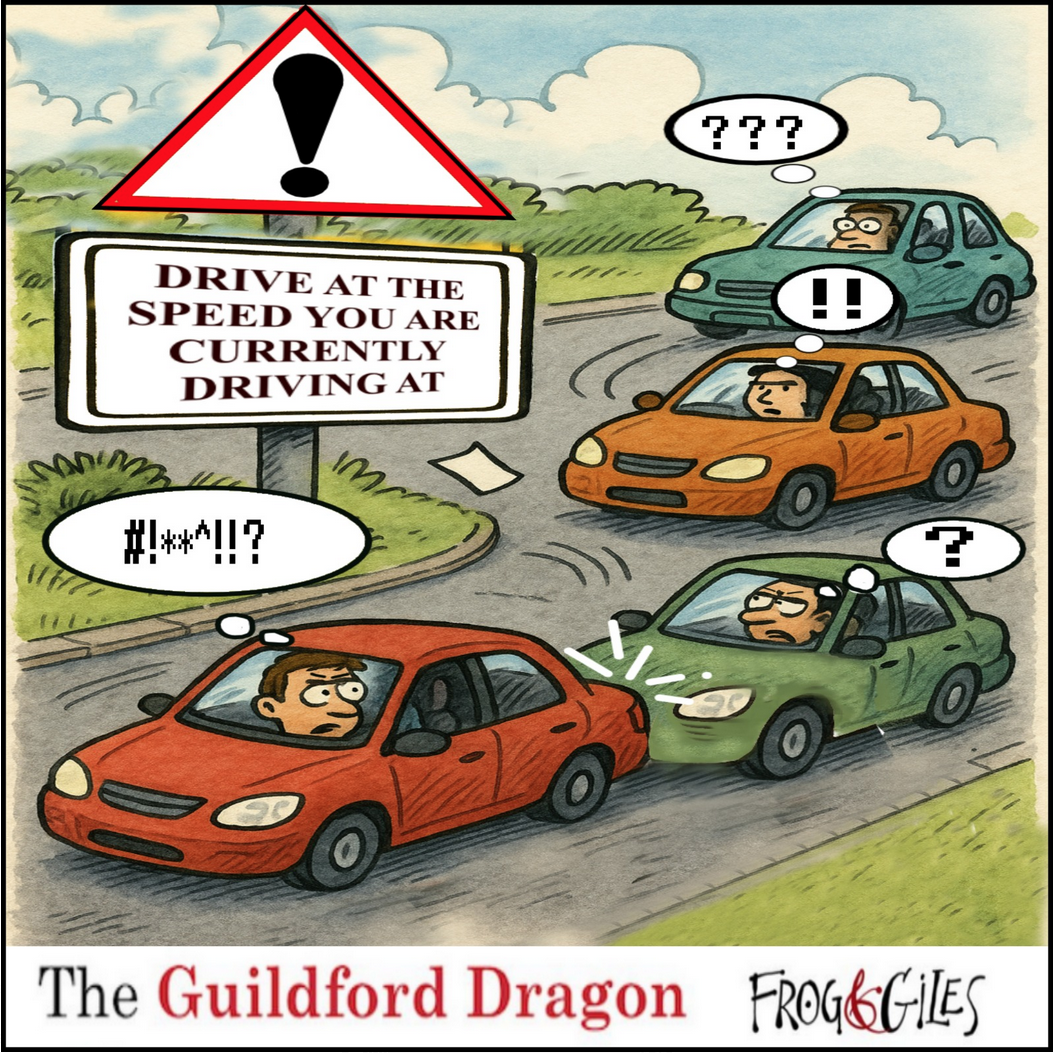
Click on cartoon for Dragon story: Public Asked for Views on SCC’s Proposal for Reduced Speed Limits


Recent Articles
- Photo Feature: Now You See It…
- Letter: Snail-paced Progress for Full Weir Repair
- Mayor’s Diary: July 5 -July 20
- One Homeowner Recompensed but Fight Continues Over Waverley CIL Charges
- Letter: Fine Those Guilty of Anti Social Behaviour
- GBC Working Hard To Mitigate Looming Weyside Urban Village Deficit
- Letter: Rapist Also Spearheaded Vicious Campaign Against the PCC
- Notice: Guildford Festival of the Arts – September 2025
- Police Investigating Wildlife Attacks At Fleet Pond Issue Three E-fits
- Wildlife Conservation Project Seeks To Protect Some of Surrey’s Rarest Habitats


Recent Comments
- Jan Messinger on Public Asked for Views on SCC’s Proposal for Reduced Speed Limits
- Fiona White on GBC Asks Residents for Views on Its Draft Building Height Guidance
- Dave Middleton on Letter: Fine Those Guilty of Anti Social Behaviour
- Carina Coverly on GBC Asks Residents for Views on Its Draft Building Height Guidance
- M Durant on Online Event Will ‘Help Residents Have Their Say On Local Government Reorganisation’
- Jim Allen on GBC Working Hard To Mitigate Looming Weyside Urban Village Deficit
Search in Site
Media Gallery
Dragon Interview: Local Artist Leaves Her Mark At One of England’s Most Historic Buildings
January 21, 2023 / No Comment / Read MoreDragon Interview: Lib Dem Planning Chair: ‘Current Policy Doesn’t Work for Local People’
January 19, 2023 / No Comment / Read MoreA3 Tunnel in Guildford ‘Necessary’ for New Homes, Says Guildford’s MP
January 10, 2023 / No Comment / Read More‘Madness’ for London Road Scheme to Go Ahead Against ‘Huge Opposition’, Says SCC Leader
January 6, 2023 / No Comment / Read MoreCouncillor’s Son Starts Campaign for More Consultation on North Street Plan
December 30, 2022 / No Comment / Read MoreCounty Council Climbs Down Over London Road Works – Further ‘Engagement’ Period Announced
December 14, 2022 / No Comment / Read MoreDragon Interview: GBC Reaction to the Government’s Expected Decision to Relax Housing Targets
December 7, 2022 / No Comment / Read MoreHow Can Our Town Centre Businesses Recover? Watch the Shop Front Debate
May 18, 2020 / No Comment / Read More






Jan Messinger
August 19, 2024 at 10:29 pm
What a lovey piece to read. Such interesting information.
Looks like people will have great times on Guildford Walkfest as there is so much history locally to discover.